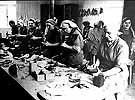 Forced and Slave Labor
Forced and Slave Labor
As the war dragged on, the Nazis' manpower needs became ever greater. The available German labor pool, however, became seriously depleted. By 1944, with increasingly more German men taken out of the work force and drafted into the Army, the need for laborers became acute. Reluctant to force women (those pictured toiled at the Ravensbrück, Germany, camp) into work for war industries, the Nazis tried to fill the growing gap by recruiting foreign laborers. These came from the ranks of the civilian population in occupied countries, from prisoners of war, and from Jews imprisoned in ghettos and labor camps. Quotas established in early 1944 required an immense mobilization of millions of additional laborers for the war effort. By the end of the year, more than nine million foreign civilians and POWs labored in the Reich. For the entire length of the war, this number totaled at least 12 million. The Nazis conscripted foreign workers (Fremdarbeiter) for forced labor in both agriculture and industry, while Jews in concentration camps toiled exclusively as slave labor for German industry. A forced-labor decree enacted in 1942 allowed Fritz Sauckel, plenipotentiary for Labor Allocation, to ruthlessly round up "recruits." His agents plucked people off city streets, from town squares, and out of churches and movie houses for forced deportation to Germany. Guided by racial principles, the treatment and working conditions of these foreign workers varied. Nazi policy regarded Eastern European workers as inferior "subhumans," subjecting them to stringent controls, harsh penalties, and strenuous physical labor. Forced to wear identifying patches, Poles and Russians received extremely low wages, could not socialize with Germans, and were confined to their quarters after work. By contrast, Western European workers received higher wages and much better treatment. Much worse, however, was the condition of Jews in Occupied Poland, who were exploited by the Nazis as slave labor in ghettos and specially constructed labor camps. Under SS jurisdiction, the camps produced a high death toll as inmates toiled through 12-hour work days while deprived of adequate food and shelter. A number of German industries exploited the readily available, cheap slave labor by locating factory compounds near or even in concentration camps. The factories in the Auschwitz region expanded during the first half of 1944, and made use of POWs in addition to Jews. The Krupp Works utilized slave labor to make steel. The munitions manufacturing firm Rheinmetall, of Düsseldorf, set up production at Buchenwald. I.G. Farben, the giant chemical cartel that produced dyes, explosives, synthetic rubber, and numerous war-related products, established an extensive subcamp system near Auschwitz. This included the Buna Works, where slave labor manufactured synthetic rubber and coal oil. The labor camp at Myslowice provided 1300 slaves for work in the Fürstengrube coal mines. At Sosnowiec, prisoners made gun barrels and shells for the Ost-Maschinenbau Gesellschaft works. The Siemens-Schukert works used children to manufacture electrical parts for airplanes and submarines. Workers were easily replaced when worn out and no longer fit for labor.
Photo: Mahn- und Gedenkstätte Ravensbrück / United States Holocaust Memorial Museum Photo Archive
|
